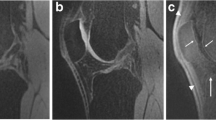Abstract.
The aim of our study was to correlate MRI with histologic findings in normal and degenerative cartilage. Twenty-two human knees derived from patients undergoing amputation were examined with 1.0- and 1.5-T MR imaging units. Firstly, we optimized two fat-suppressed 3D gradient-echo sequences. In this pilot study two knees were examined with fast imaging with steady precession (FISP) sequences and fast low-angle shot (FLASH, SPGR) sequence by varying the flip angles (40, 60, 90 °) and combining each flip angle with different echo time (7, 10 or 11, 20 ms). We chose the sequences with the best visual contrast between the cartilage layers and the best measured contrast-to-noise ratio between cartilage and bone marrow. Therefore, we used a 3D FLASH fat-saturated sequence (TR/TE/flip angle = 50/11 ms/40 °) and a 3D FISP fat-saturated sequence (TR/TE/flip angle = 40/10 ms/40 °) for cartilage imaging in 22 human knees. The images were obtained at various angles of the patellar cartilage in relation to the main magnetic field (0, 55, 90 °). The MR appearances were classified into five categories: normal, intracartilaginous signal changes, diffuse thinning (cartilage thickness < 3 mm), superficial erosions, and cartilage ulcers. After imaging, the knees were examined macroscopically and photographed. In addition, we performed histologic studies using light microscopy with several different stainings, polarization, and dark field microscopy as well as electron microscopy. The structural characteristics with the cartilage lesions were correlated with the MR findings. We identified a hyperintense superficial zone in the MR image which did not correlate to the histologically identifiable superficial zone. The second lamina was hypointense on MRI and correlated to the bulk of the radial zone. The third (or deep) cartilage lamina in the MR image seemed to represent the combination of the lowest portion of the radial zone and the calcified cartilage. The width of the hypointense second zone correlated weakly to the accumulation of proteoglycans in the radial zone. The trilaminar MRI appearance of the cartilage was only visible when the cartilage was thicker than 2 mm. In cartilage degeneration, we found either a diffuse thinning of all layers or circumscribed lesions (“cartilage ulcer”) of these cartilage layers in the MR images. Early cartilage degeneration was indicated by a signal loss in the superficial zone, correlating to the histologically proven damage of proteoglycans in the transitional and radial zone along with destruction of the superficial zone. We found a strong effect of cartilage rotation in the main magnetic field, too. A rotation of the cartilage structures caused considerable variation in the signal intensity of the second lamina. Cartilage segments in a 55 °angle to the magnetic main field had a homogeneous appearance, not a trilaminar appearance. The signal behavior of hyaline articular cartilage does not reflect the laminar histologic structure. Osteoarthrosis and cartilage degeneration are visible on MR images as intracartilaginous signal changes, superficial erosions, diffuse cartilage thinning, and cartilage ulceration.
Similar content being viewed by others
Author information
Authors and Affiliations
Additional information
Received 13 February 1997; Revision received 27 June 1997; Accepted 29 December 1997
Rights and permissions
About this article
Cite this article
Uhl, M., Ihling, C., Allmann, K. et al. Human articular cartilage: in vitro correlation of MRI and histologic findings. Eur Radiol 8, 1123–1129 (1998). https://doi.org/10.1007/s003300050519
Issue Date:
DOI: https://doi.org/10.1007/s003300050519




